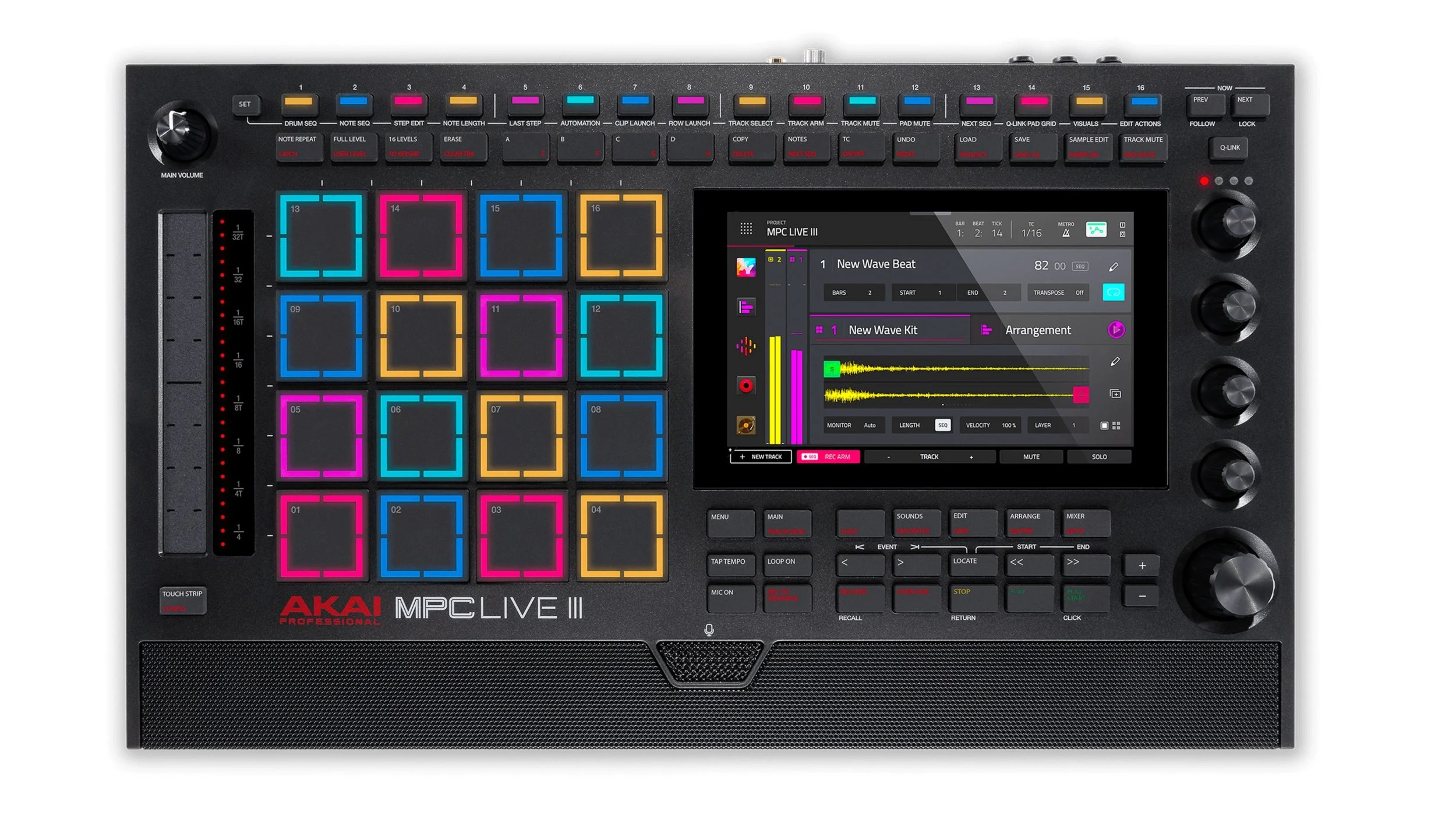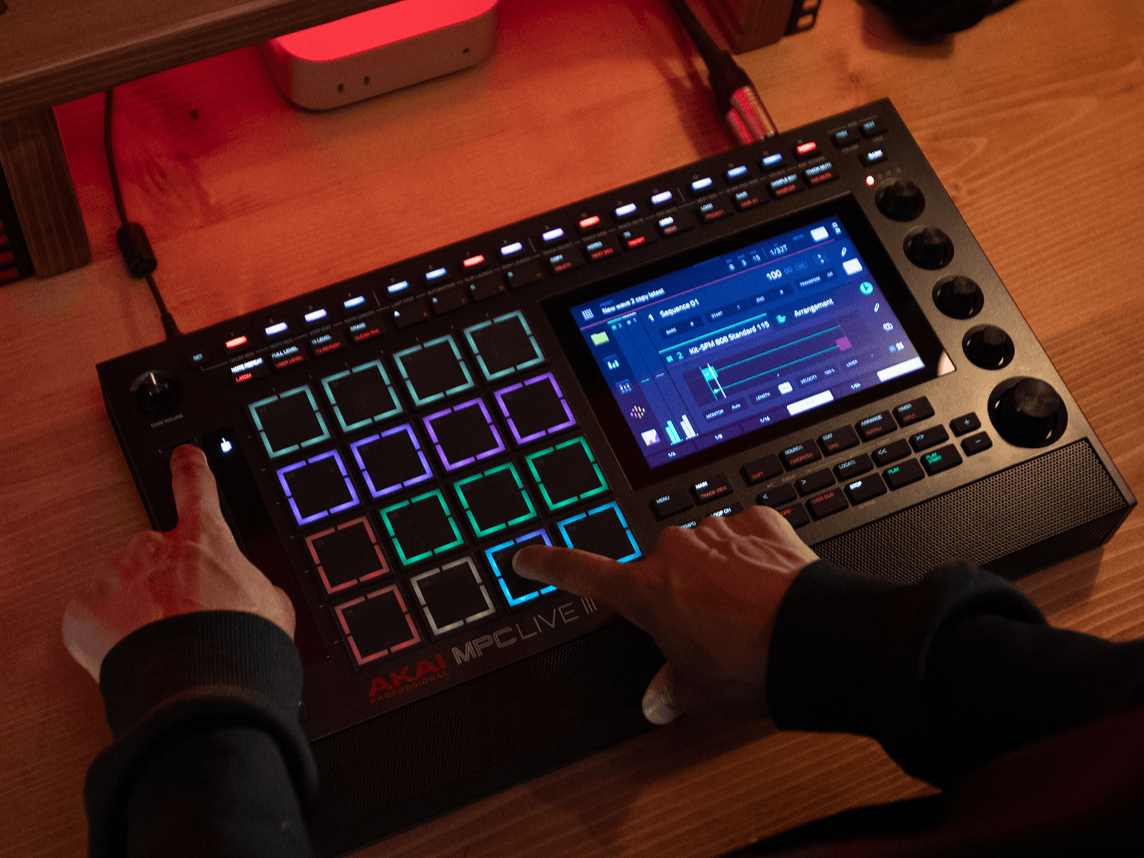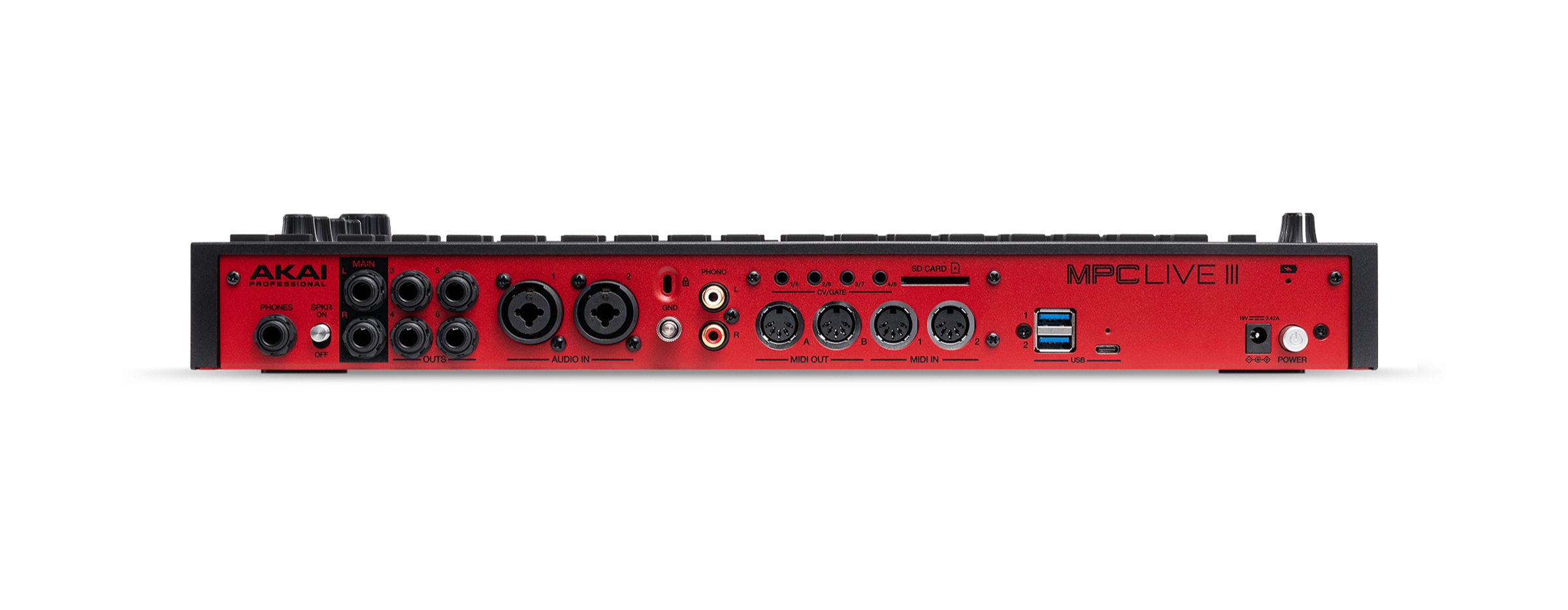Akai MPC Live III: A True Leap Forward for Standalone Beatmaking

Few pieces of music hardware carry as much weight as the Akai MPC. From its golden-age hip hop roots to its role in shaping electronic production across decades, the MPC has always stood for tactile, sample-driven creativity. In recent years, Akai has doubled down on standalone power, giving producers the ability to leave the laptop behind without losing professional features. With the arrival of the MPC Live III, Akai is making its boldest move yet — one that blends its iconic pad-driven workflow with cutting-edge upgrades. The MPC Live III isn’t just a spec bump; it’s a reimagining of what a standalone production unit can do in 2025. With 3D-sensing MPCe pads, a dedicated step sequencer, clip launching, and a serious boost in processing power, this machine aims to be both a studio centerpiece and a live performance powerhouse. But with added features comes a steeper learning curve — and a higher price tag. So is this the ultimate MPC yet, or just another iteration in a crowded field of standalone gear? Let’s dig in.
TL;DR — MPC Live III at a Glance
What it is – A next-gen standalone sampler and sequencer with major hardware and workflow upgrades.
What it’s for – Beatmaking, live performance, clip-based sets, expressive finger drumming, and laptop-free music production.
What’s new – 3D-sensing MPCe pads, a 16-step sequencer, clip launching, a huge 8-core CPU with 8GB RAM, and Pro Stems separation.
Why it’s different – Combines classic MPC sampling heritage with modern performance tools and expressive multidimensional control.
Who it’s for – Producers, beatmakers, and performers who want a fully portable, standalone music hub that can handle pro-level projects.
Alternatives – Ableton Push 3 (standalone), Maschine+, Roland SP-404MKII, Akai Force.
This site contains affiliate links. If you book or purchase through these links, I may earn a commission at no extra cost to you. This helps support the site and keeps my content free. As an Amazon Associate, I earn from qualifying purchases.
What the MPC Live III Is
The MPC Live III takes everything Akai built with the Live II and pushes it into new territory. At its core, this is still a standalone sampler and sequencer — a box you can use to make full tracks without ever touching a computer. But the spec sheet shows how far it’s come: an 8-core processor, 8GB of RAM, and 128GB of internal storage put it leagues ahead of its predecessor. That translates to more plugin instances, more tracks, and smoother performance for complex sessions.
Beyond raw power, the Live III introduces features that change how you interact with it. The MPCe pads are the biggest headline: they sense not only velocity and pressure but also the position of your finger on the pad. That means you can bend, morph, and articulate sounds in a way no previous MPC allowed. Alongside them sits a dedicated 16-step sequencer, a first for the MPC line. It gives you a groovebox-style workflow, with probability, ratchets, and automation at your fingertips.
And while it’s clearly aimed at producers who want depth, Akai hasn’t ignored practicality. The built-in mic, speakers, and rechargeable battery make it as portable as it is powerful. You can sketch an idea anywhere, sample a sound on the fly, and build full tracks without any extra gear. It’s this balance between muscle and mobility that makes the Live III feel like a true generational leap, rather than a minor refresh.
Pads, Sequencer, and Workflow
The biggest talking point on the MPC Live III is without doubt its new MPCe pads. They’re still the classic 16-square layout, but now each pad senses position along the X and Y axis as well as velocity and pressure. That means you can slide across a pad to open a filter, morph a sound between layers, or control multiple parameters in real time. It’s a subtle shift that feels instantly natural — as if the MPC pads finally caught up with the way people have always wanted to play them. For finger drummers, beatmakers, and live performers, this change is transformative.
Right beside the pads, the 16-step sequencer adds another layer of immediacy. Each step can handle automation, probability, ratchets, and micro-timing, letting you build patterns in a groovebox style without diving into menus. It’s perfect for sketching quick ideas or dialing in intricate rhythmic detail. The Live III manages to balance its deep sequencing engine with this more hands-on approach, meaning you can jump between improvisation and structure seamlessly.
Workflow is also streamlined by clip launching, a feature borrowed from Akai’s Force. Instead of arranging tracks in a rigid timeline, you can trigger loops and phrases on the fly, build arrangements dynamically, and perform full sets directly from the machine. Combined with the pads and sequencer, it pushes the MPC beyond beatmaking and into the realm of hybrid performance tools — the kind of setup you’d be just as comfortable with in a studio as on stage.
Connectivity, Sound, and Stems
One of the strongest aspects of the MPC Live III is how it connects with the outside world. On the back panel, you’ll find combo mic/line inputs, MIDI I/O, CV/Gate outputs, and multiple outputs, giving you everything from traditional studio routing to modular synth integration. The shift to USB-C also means faster data transfer and, more importantly, multi-channel audio streaming. You can send separate tracks into your DAW or pull in sounds from external sources with minimal fuss. For anyone juggling a hybrid hardware/software setup, that’s a massive quality-of-life improvement.
Portability hasn’t been forgotten either. The built-in microphone lets you sample anything on the spot, while the integrated speakers give you a way to monitor ideas without headphones or studio monitors. Coupled with the rechargeable battery, it really is a box you can carry anywhere and still make serious music. That said, battery life hovers around four hours, which is enough for a writing session but not an all-day marathon. Still, the ability to go completely untethered remains a defining part of the Live III’s appeal.
Another standout feature is Pro Stems integration. Unlike the limited “efficient” stem separation on earlier MPCs, the Live III runs the full, high-quality version, powered by zplane technology. This means you can isolate vocals, drums, bass, and other elements from a track directly inside the hardware, opening up creative sampling possibilities without ever touching your laptop. For DJs, remixers, and sample-based producers, this feature alone makes the Live III feel ahead of its time.
Real-World Use and Limitations
On paper, the MPC Live III looks unstoppable — and in practice, most reviewers agree it delivers. The sheer power of the 8-core processor and expanded RAM means projects run more smoothly than ever, with fewer limits on plugin instances and track counts. The new pads are immediately responsive, adding an expressive layer that feels intuitive once you start experimenting. And the step sequencer, paired with clip launching, makes this MPC just as viable for live performance as it is for beat production.
But with great power comes added complexity. The front panel is busier than before, packed with extra buttons to accommodate new workflows. For newcomers, that can feel overwhelming, and even experienced MPC users may need to adjust. Reviewers also noted quirks with the touchscreen interface — for example, you can’t drag clips around as freely as you might expect, and some editing tasks require more steps than they should. These aren’t dealbreakers, but they remind you this is still a deep machine with a learning curve.
Price is another consideration. The MPC Live III is a premium investment compared to the Live II, and while the improvements are substantial, not every user will need this level of horsepower. Battery life, too, remains average at about four hours — enough for writing sessions, but not ideal if you rely on it heavily while away from a power source. Still, if you’re looking for the most capable standalone sampler-sequencer available right now, these trade-offs may be worth it.
Alternatives to Consider
If the MPC Live III feels like overkill, or if you’re weighing your options, there are a few other standalone and groovebox-style devices worth considering.
The most obvious rival is the Ableton Push 3 standalone controller. Push excels at deep integration with Ableton Live, making it the natural choice for producers already locked into that ecosystem. It doesn’t have the same sampling heritage as the MPC, but its clip-based workflow is more fluid, and the standalone edition has quickly gained traction among laptop-free performers.
Another contender is Maschine+ by Native Instruments. It offers a similar balance of sequencing, sampling, and plugin hosting, though its hardware hasn’t kept up with Akai’s latest specs. Updates have been slower, too, which leaves some users questioning its long-term support. Still, for NI fans with large sound libraries, it’s a solid option.
If you’re looking for something leaner, the Roland SP-404MKII is a cult favorite. It doesn’t come close to the Live III in terms of processing power or sequencing depth, but it shines with immediacy and vibe — making it a go-to for live sample flipping and lo-fi workflows. Meanwhile, Akai’s own Force remains the more “Ableton-like” option within their lineup, offering deeper clip-launching capabilities at the cost of portability.
Pros and Cons
Pros
Huge leap in CPU, RAM, and storage
MPCe 3D pads add expressive, multidimensional control
16-step sequencer and clip launching expand creative workflow
Pro Stems separation built into hardware
Portable design with mic, speakers, and battery
Cons
Higher price compared to MPC Live II
Denser interface and steeper learning curve
Some workflow quirks in the touchscreen and clip editing
Battery life still averages around 4 hours
Final Words
The MPC Live III is more than just the next entry in Akai’s iconic line — it’s a statement about where standalone music production is headed. With its powerful new processor, expressive 3D pads, and expanded sequencing tools, it bridges the gap between studio centerpiece and live performance rig. For producers who want to break free from the laptop without losing depth or flexibility, this is the strongest MPC yet.
That doesn’t mean it’s for everyone. The learning curve is steeper, the price is higher, and battery life is still a compromise. But for beatmakers, sample heads, and performers who crave a fully self-contained environment, the Live III is a machine that feels like the future. If you’ve been waiting for an MPC that can truly handle everything without a computer, this is the one.
This site contains affiliate links. If you book or purchase through these links, I may earn a commission at no extra cost to you. This helps support the site and keeps my content free. As an Amazon Associate, I earn from qualifying purchases.




